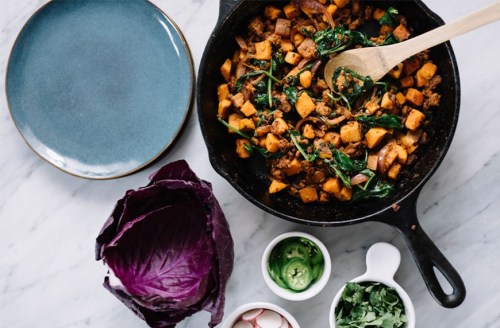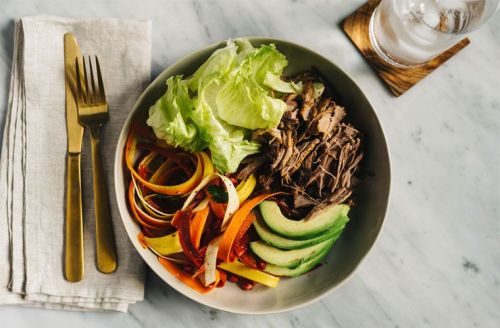Paleo vs. Whole30: Which one is better for you?
Here's everything you need to know about the Paleo diet and Whole30 meal plan: what you can eat, what you can't, and the potential health benefits of each.

With so many diets making the rounds—seriously, what haven’t they thought of yet?—it’s not uncommon for some of them to start jumbling up in your brain. While some focus on healthy fats (hello, keto), others forbid all animal products (vegan FTW). And when it comes to two of the most popular—Paleo and Whole30—things can get even more confusing because of how similar they are.
These eating philosophies have inspired such serious devotion (they’re basically the food version your CrossFit-obsessed friend) that you’ve probably heard about them a lot over brunch. Consider this guide the real lowdown—here’s everything you need to know before revamping your eating habits (and transforming your pantry).

Paleo 101
The whole idea of the Paleo diet is eating how your ancestors ate—which, if you want the TL;DR, was very basic—but also very wholesome. The cavewomen who came before you weren’t able to just walk into a grocery store and pick up a box of crackers and the finest of vegan cheeses. They were hunters and gatherers, so that’s what this meal plan sticks to: foods from the Paleolithic era that are thought to be better for the body.
So, what can you eat when you’re Paleo? You’re good to go with some of your ancestors’ faves: meat, fish, seafood, fruit, veggies, nuts, seeds, eggs, tubers, herbs, spices, and healthy oils (coconut oil, avocado oil, extra-virgin olive oil). And even though they weren’t used way back when, you can also eat ghee, honey, alcohol, bacon, salt, and coffee. A couple rules: With alcohol, just be sure it’s distilled liquors (vodka, tequila, and brandy) or red wine, and it’s recommended that all meat is grass-fed, pasture-raised, and organic.
What can’t you eat when you’re Paleo? Some Paleo no-nos include grains (like whole grains, quinoa, oats, and brown rice), legumes (like beans, peanuts, chickpeas, lentils, and soy), dairy, vegetable oils (soybean oil, grapeseed oil), hydrogenated oils (margarine), sugar, high-fructose corn syrup, artificial sweeteners, and processed foods.
Even though you have plenty of different foods to enjoy on the Paleo diet, banning grains and legumes from your life could be a major drawback. “Cutting out grains and legumes cuts out valuable sources of B vitamins and plant-based prebiotic fibers, which nourish the microbiome,” says Monica Auslander Moreno, MS, RD, LD/N, nutrition consultant for RSP Nutrition. “A lot of people also report feeling less full without grains/legumes in their meals, so there is the potential that you could overconsume the protein/fat portion to compensate.”

Whole30 101
While the Paleo diet is a blast from the past and is meant to be a lifestyle, Whole30 is an elimination diet that has you remove all foods that are potential troublemakers—whether they trigger sensitivities or are linked to cravings—over the course of 30 days. Then, you slowly reintroduce those foods back into your meals. Basically, it’s a reset that can help you figure out which types of foods work for you and which ones don’t.
“Shifting the focus of a dietary pattern to fresh fruits, vegetables, tubers, non-breaded/fried proteins, nuts, seeds, spices, and healthy fats will lead to increases in fiber, phytochemicals (beneficial plant chemicals), and beneficial fatty acid intake,” says Moreno. “Since Whole30 prohibits refined flours, added sugar, and most processed foods—and ‘whole’ foods will likely replace those in one’s diet—nutrient quality overall will improve and added sugar intake will decrease, which usually leads to fewer cravings and enhanced energy.”
So, what can you eat when you’re on Whole30? The things you can devour on Whole30 are fruits, veggies, potatoes, meat (nothing processed), eggs, fish, nuts, seeds, oil (olive oil and coconut oil), ghee, and coffee. Yep, the list is shorter… but at least there’s coffee, right?
What can’t you eat when you’re on Whole30? When it comes to what you can’t eat on Whole30, the diet forbids dairy, grains (like whole grains, quinoa, oats, and brown rice), legumes (like beans, peanuts, chickpeas, lentils, and soy), sugar, artificial sweeteners, processed foods, and alcohol. You also can’t eat junk food, even if you recreate it using healthy, diet-compliant ingredients. The thinking is, it can make you cave and want the real thing, which totally defeats the purpose of a plan that’s supposed to help you beat your cravings.

The similarities and differences
They have a lot in common, actually. Both diets have a heavy focus on eating mostly real food sources—like fruit and veggies!—and ridding your cabinets of anything processed. Aside from banning the boxed stuff, neither of them allow you to eat common diet staples, like grains, legumes, sugar, and dairy, either.
But here’s where they diverge: Because Whole30 is only 30 days, it’s much more strict. If you deviate from the plan at all, you have to start the 30 days over. Paleo, on the other hand, is meant to be more of a long-haul approach. Because of that, it’s a little more relaxed, letting you #liveyourbestlife and have more freedom in certain areas, like alcohol.
Which one is right for you?
Those who choose Whole30 usually do so to either discover food sensitivities, beat a sugar addiction, or better their relationship with food and change their habits. People who choose Paleo, on the other hand, might already know their intolerances or allergies and want to eat from a plan that keeps their health in check. That’s why it’s often recommended to those with chronic illnesses, since it bars common allergens (like dairy and grains), so it’s very anti-inflammatory.
Whether you choose one of these options or abide by a plan that allows you to be more balanced, always go for what feels right to you. And the good news? If one isn’t working, there are plenty of other options to try.
Emmy Rossum sweetens her Paleo muffins with these two extra-healthy secret ingredients. Or try these Whole30-compliant salad dressing recipes to keep your desk lunch anything but sad.
Sign Up for Our Daily Newsletter
Get all the latest in wellness, trends, food, fitness, beauty, and more delivered right to your inbox.
Got it, you've been added to our email list.










